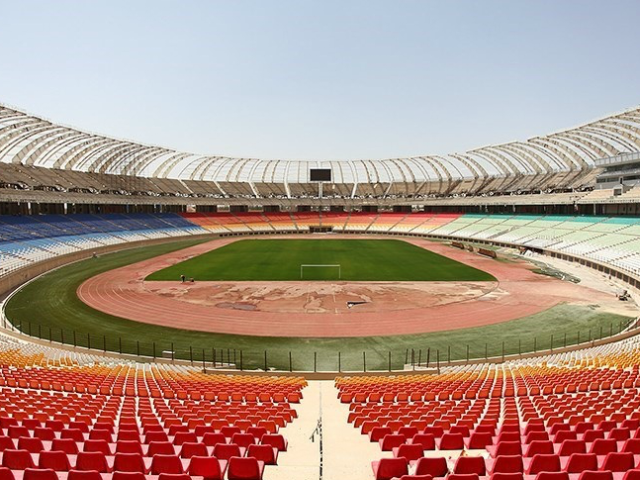Video surfacing on social media reportedly shows an Iranian soccer stadium chanting “death to the dictator” in unison, a sign that the Islamic regime has failed to quell protests against its oppression.
Al-Arabiya, a Saudi news outlet that often publishes reports critical of Iran, identifies the location as the Naghsh-e Jahan Stadium in Isfahan, the nation’s second-largest stadium with a capacity of 75,000 people. The stadium typically hosts soccer games. Al-Arabiya suggested that “death to the dictator” was the clearest, but not only, chant against the government in the undated video.
“As soon as the masses began to chant ‘death to the dictator,’ riot police and internal security personnel began to deploy at the stadium in anticipation of increased protests,” the Saudi outlet reports.
The National Council of Resistance of Iran (NCRI), an opposition group working outside of Iran to support dissidents within the country’s borders, published video of the incident on Twitter, where it had spread rapidly among social media accounts.
Fans chant ‘death to the dictator’ in #Iran’s Naghsh-e Jahan Stadium
A popular uprising sweeping #Iranian cities has now spread 2 squares and football stadiums amid continuing anger over political & economic policies of the Iranian regime. #IranProtest #RegimeChange #FreeIran pic.twitter.com/d2MOSGXmnV— NCRI-FAC (@iran_policy) January 16, 2018
The NCRI has been one of the most successful groups to extract videos and photos of dissident activity in Iran since protests began on December 27. The Iranian government temporarily shut down Instagram and Telegram, two of the nation’s most popular social media outlets, after the protests began.
Reports indicate that skyrocketing prices for eggs and other basic foods triggered the initial round of protests in December, but that organized secularist protesters then began chanting slogans such as “death to the dictator,” “death to [Iranian President Hassan] Rouhani,” and “death to Hezbollah.”
Protesters in over 90 cities began to demand that Iran stop investing millions in the terrorist group Hezbollah and military campaigns in Iraq, Syria, and Yemen and instead use the billions the nation received from the 2015 Joint Comprehensive Plan of Action (JCPOA)—the “Iran nuclear deal”—to improve the lives of Iranian citizens. In addition to supporting Hezbollah, the Iranian government also reportedly provides strategic aid to the Shiite militias within the Popular Mobilization Units (PMU/PMF), a coalition of militias operating on behalf of the government in Baghdad that united to fight the Islamic State, but have since refocused their weapons towards the Iraqi Kurds.
In response, Iran not only shut down social media in the country but reportedly launched a disinformation campaign on social media platforms, using Twitter “bots” to share false photos of empty protests and discourage Iranians from participating in them. The Iranian regime also staged large pro-government rallies in response to the protests.
Reports suggest that as many as 8,000 people have been arrested since late December, many kept from communicating with loved ones within some of Iran’s most notorious prisons. The Iranian government has kept their official arrest tally under one thousand and claimed to release hundreds from custody this week.
On Monday, reports revealed that two protesters—Saro Ghahremani, 24, and Ali Poladi, 26—died in police custody. Iranian police claimed they committed suicide, though reports indicate they were tortured to death and relatives have complained that police appeared to keep the families from their bodies and rapidly bury the men out of sight.
The two young men join Sina Ghanbari, 23, and Vahid Heydari, 22, who both “committed suicide” in an Iranian prison last week. Amnesty International has called for the release of all remaining prisoners. The deaths have triggered panic among the loved ones of those protesters still behind bars and impromptu protests of relatives who have demanded to see their loved ones in prison and been denied.
The official death toll in Iran’s protests stands at 25, though some have suggested that number is significantly higher.
Iran has blamed a combination of the United States, Saudi Arabia, and the Iraqi Kurdistan Regional Government (KRG) for conspiring to bring about the protests.

COMMENTS
Please let us know if you're having issues with commenting.